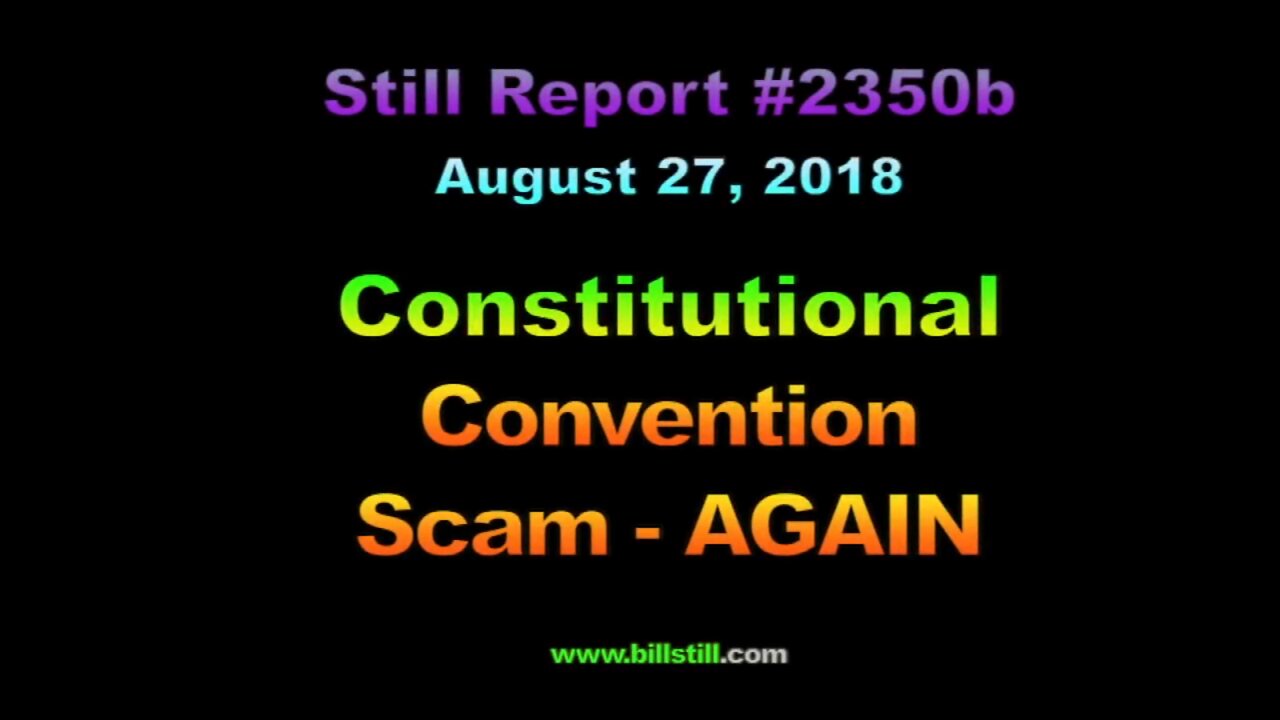Premium Only Content

SR-2350b - Constitutional Convention Scam - AGAIN
“Hold on, my friends, to the Constitution and to the Republic for which it stands. Miracles do not cluster and what has happened once in 6,000 years, may not happen again. Hold on to the Constitution, for if the American Constitution should fail, there will be anarchy throughout the world.” ― Daniel Webster
I apologize that this report consumed over
3 days to produce. Unfortunately, in one
form or another, weakened substitutes for
the U.S. Constitution will continue to
reappear, because our Constitution, with
its precious Bill of Rights, is such a thorn
in the side of globalism. Hopefully these
quotes will not be lost to history, and
subsequent generations.
Good evening , I’m still reporting on coup. I apologize that this took so long.
Unfortunately for many well-meaning Constitutional conservatives calling for a second Constitutional Convention is all a part of the on-going coup plot which spans decades, if not centuries.
There is absolutely nothing new about this Con-Con con. About 30 years ago, I played a part in bringing about Florida’s withdrawal from its Constitutional Convention call.
Shortly thereafter, at the invitation of legendary Constitutional activist, attorney Phyllis Schlafly, I went to the New Jersey capitol to attend a hearing about New Jersey’s Con-Con call.
Mrs. Schlafly was my mentor in everything I’m about to discuss – a discussion which flies in the face of a handful of well-intended but mis-informed conservative Constitutional scholars, including Mark Levin.
Last Sunday, Mr. Levin had on as guests, former U.S. Senator, Dr. Tom Coburn, and attorney Mark Meckler, one of the leaders of the Tea Party movement.
I don’t know why these three attorneys can’t see what’s going on here. I’m completely in their corner when it comes to deconsolidation of power. The federal government has usurped way too much of the power of the sovereign states. The question is what is the best way to get it back.
My contention is that there is no magic bullet. The cause is good and noble and true, but the only way to do this is like every other change wrought through the political process – work slowly and surely and within the protections of our Constitutional framework. Be careful when opening the door to wholesale change of our precious Constitution. We aren’t going to change this through one magjc convention, and anyone who offers such a magic solution should be told to slow down and consider the following facts.
[insert note #1]
This is the core argument for the Constitutional Convention. Now let’s look at the text of Article 5 of the U.S. Constitution:
“The Congress, whenever two thirds of both houses shall deem it necessary, shall propose amendments to this Constitution, or, on the application of the legislatures of two thirds of the several states, shall call a convention for proposing amendments, which, in either case, shall be valid to all intents and purposes, as part of this Constitution, when ratified by the legislatures of three fourths of the several states, or by conventions in three fourths thereof, as the one or the other mode of ratification may be proposed by the Congress.”
Notice that if what Mr. Meckler says is true, that taking power away from a runaway Congress was the core impetus for adding that the Con-Con could be called by “two thirds of the several states”, well that sounds right – right?
No, wrong, and here’s why. Look at the ratification process in the last clause of Article 5.
“… when ratified by the legislatures of three fourths of the several states, or by conventions in three fourths thereof, as the one or the other mode of ratification may be proposed by the Congress.”
Two points: tell me, who are the peoples’ representatives in a sovereign state? Their legislature. So, let’s say that the next few words are to provide for a situation where the state legislators are not to be trusted with voting on the ratification of the new Constitution. Then who gets to vote?
“… or by conventions in three fourth thereof…”
Well, ok, that sounds like a good backup, but who would decide how these folks are going to be selected for this convention. That’s a pretty important detail. Maybe Congress would declare that only Democrat senators from the several states would get to be voters in these state conventions. But the final phrase in Article 5 provides important context for this critical question:
“… as the one or the other mode of ratification may be proposed by the Congress.”
Yup, you see the basic problem here. Congress gets to decide which ratification process will be used, and NO DOUBT Congress will decide which way favors the status quo, don’t ya think?
Now that’s just the basic problem, but there are tons of other problems and legal scholars for the last 60 years have weighed in on them.
[insert @ Note 2 to Note 3]
And that is exactly why Madison noted that there was “no comment” when this question was brought up. Because as written, Congress controls the entire process, and there isn’t really a foolproof way to solve this other than returning to the normal, slow-but-sure amendment process. NO MAGIC BULLET!
[insert up to Note 4]
Because they aren’t so blind as to not see that last word in Article 5 – that word is “Congress”! So let’s say that the Dems win the House and Senate in November 2018. So what do you think returning Speaker, Nancy Pelosi, will do when and if 34 states pass Con-Con resolutions with the stated purpose of making abortion illegal and mandating a balanced federal budget? Pelosi would be in charge of the House of Representatives.
Do you think she will say:
“Gee, it’s up to me to decide how this should be ratified. I could let the state legislatures decide, but they are heavily Republican, so all this would probably pass. Or I could insist on a ratification process that allowed only members of my caucus to serve in the state conventions. I mean, Fox News will be screaming, but we control the rest of the media, so we can definitely pull this off.”
[insert Note 4-5]
Well, Dr. Coburn, false bravado based on an incomplete understanding of the battlefield space is the graveyard of many a pretentious fool.
[insert Note 5-6]
Well, Dr. Coburn, I’ve been in this for half my lifetime and I’ve never seen any leftist money behind opposition to the Con-Con. The big money has always been from the deep state rightists trying to get it across the finish line.
And let me say one more thing. Have you ever seen a single valid criticism of Phyliss Schlafly’s conservative credentials? No! She was always the absolute core of rib-rock conservative thinking.
[insert Note 7-8]
No, Mark, you’re making stuff up. The second option is ratification by:
“…conventions in three fourths thereof, as the one or the other mode of ratification may be proposed by the Congress.”
[insert Note 9-10]
Exactly! And, other than a few on the Republican conservative side of the fence, we don’t have anywhere near that class of citizen any more. So why would you open the entire document up to wholesale change with a bunch of lock-step Democrats enmeshed in this process?
[insert 11-12]
[insert marker 15-16]
Well, yes, there actually is, and a lot of smart people have written a lot explaining it over the years. There are two major reasons to fear the Con-Con:
1. The vast majority of experts agree that the convention cannot be held to a single issue. It will become a "runaway" convention.
2. Even if a runaway convention could be absolutely stopped – and it cannot - there is a way to bypass the normal ratification process by the state legislatures. This is known as the “backdoor” ratification procedure of Article V of the Constitution. Congress cannot only appoint all the delegates to the convention; and make all the rules; they could even appoint themselves as the duly elected ratification body for the new constitution.
Most state legislators pass Con-Con legislation only after seemingly ironclad assurances that the Constitution won't be opened up to radical changes.
During the last big runup in the 1980s, proponents of the Con-Con claimed that the convention could be limited to a single issue. However, thirty-two states passed a Con-Con call for a “balanced budget” amendment, twenty of them have also issued calls for a convention to consider a Right-To-Life amendment (BBA). Others have tacked on calls for term limits for members of Congress. You certainly can’t have it both ways.
Former Chief Justice of the U.S. Supreme Court, Warren Burger believed no one could limit a Con-Con once convened. In a January 30, 1987 speech in Detroit, he said:
“There is no way to put a muzzle on a constitutional convention.” [i]
Less than nine months after the thirty-second state called for a Con-Con in the 1981 run-up, former Secretary of Defense Melvin Laird was so concerned, he wrote an article in The Washington Post in which he outlined the dangers of a Con-Con:
“There is no certainty that our nation would survive a modern-day convention with its basic structures intact and its citizen’s traditional rights retained. The convening of a federal constitutional convention would be an act of the greatest magnitude for our nation. I believe it would be an act fraught with danger and recklessness.... there is little or no historical or constitutional guidance as to its proper powers and scope.” [ii]
Those who think a Con-Con, could be restricted to just one issue, would do well to consider Secretary Laird’s analysis:
“The only precedent we have for a constitutional convention took place in Philadelphia in 1787. That convention, it must be remembered, broke every legal restraint designed to limit its power and agenda.” [iii]
Fortunately for America, the founding fathers were very well intentioned. We would probably not be so lucky a second time. The Dean of the William & Mary Law School, former U.S. Senator William B. Spong, Jr. wrote in 1987:
“It is doubtful that a modern day convention could be limited to a single issue. There is no guarantee that, once the delegates are convened, Pandora’s box would not be opened by groups concerned with a single issue or special interest, placing at risk all of the language of our Constitution, including the Bill of Rights.” [iv]
It must be pointed out that most state legislators who have voted for a Con-Con have done so with the best intentions, but with little thought for the larger issues at hand. Ironically, while a constitutional convention could totally alter our way of life, the petitions for a convention have often been hastily passed with little debate. Over one-half of the states calling for a convention have done so without the benefit of public hearings, debate or recorded vote. [v]
Why a Con-Con? The idea is not new. President Woodrow Wilson’s closest advisor, Colonel House thought the U.S. Constitution was the product of eighteenth-century minds, and was so thoroughly outdated that it should be “scrapped and rewritten.” [vi]
In 1947, two prominent CFR members, Norman Cousins and James P. Warburg, formed something called the United World Federalists to try to merge the U.S. into the United Nations.
Ronald Reagan was associated with this group before he became a conservative in the early 1960s. [vii] This group actually got twenty-seven state legislatures to pass resolutions demanding a Con-Con to “expedite and insure” U.S. participation in a world government. By the end of 1950, however, most states had repealed the resolutions once the consequences of a Con-Con became clear.
In 1954, Sen. William Jenner warned that the Con-Con was not dead, but only sleeping.
“We have operating within our government and political system, another body representing another form of government, a bureaucratic elite which believes our Constitution is outmoded....” [viii]
In 1974, the same year President Nixon resigned, Rexford Guy Tugwell, one of the “academic liberals” from the old FDR ”brain trust” of the 1930s, published a book called The Emerging Constitution. It claimed that our old Constitution was too cumbersome and needed drastic change. It proposed something called a Constitution for the Newstates of America. The Newstates Constitution proposed to replace the 50 states with between ten and twenty regional Newstates;
“Which would not be states at all but rather subservient departments of the national government.
The Bill of Rights would be discarded.
“The bearing of arms or the possession of lethal weapons shall be confined to the police, members of the armed forces, and those licensed under law.”
Freedom of religion would no longer be considered a “right,” but a revocable “privilege.” In addition, the Newstates Constitution gives the President of the Newstates of America a nine-year term, and allows him to appoint most of the 100 Senators to lifetime terms.
The House of Representatives would have 100 members elected at-large as a single ticket with the President and Vice President (for nine-year terms). [ix]
In the 1970’s the Ford Foundation spent twenty-five million dollars over ten years to produce and promote the Newstates Constitution.
In late 1975, something called the World Affairs Council sponsored the preparation of yet another document called “A Declaration Of INTERdependence.” Written by CFR member Henry Steele Commager, it was meant to replace the Declaration of Independence in time for its 200th birthday at a ceremony in Philadelphia in 1976. It included the following;
“Two centuries ago our forefathers brought forth a new nation; now we must join with others to bring forth a new world order.... To establish a new world order of compassion, peace, justice and security, it is essential that mankind free itself from the limitations of national prejudice and acknowledge that ... all people are part of one global community....
“..that we may preside over a reign of law that will not only end wars but end as well that mindless violence which terrorizes our society even in times of peace.” [x]
This was signed by more than 100 U.S. Senators and Congressmen. [xi] After the Declaration Of INTERdependence became the subject of controversy, many of the legislators withdrew their support.
This Declaration of Interdependence was launched on March 22, 1945 with a gala event at the Hollywood Bowl. It I important to understand that the tenets espoused in it have been the philosophical core of the leftist Hollywood elite ever since.
The error in logic is as subtle as it is ancient, and therefore worth repeating. As predicted in Biblical prophecy, once the power vested in nations is transferred to a single world authority, we can be sure that the reign of the Antichrist will begin. Without a system of checks and balances, no earthly authority is corruption-proof.
Since 1975, as many as forty draft versions of the revised constitution have been prepared. [xii] By 1984, a more toned-down version was presented by a group known as the Committee on the Constitutional System (CCS). The CCS proposal includes the following:
• Permit the President to dissolve Congress (when he thinks Congress is ‘intractable’) and call for new Congressional elections.
• Eliminate the 22nd Amendment which limits a President to two terms.
• Reduce the cost of Presidential and Congressional elections by holding them at irregular intervals so that the date would not be known very far in advance, similar to the British Parliamentary system. [xiii]
The true intentions of this group, however may be revealed by one of its board members, James MacGregor Burns, a professor and historian who in 1984 wrote the following analysis of the situation for CCS members.
“Let us face reality. The framers [of the Constitution] have simply been too shrewd for us. They have outwitted us. They designed separate institutions that cannot be unified by mechanical linkages, frail bridges, [or] tinkering. If we are to turn the founders upside down ... we must directly confront the Constitutional structure they erected.”[xiv]
What are they after?
Basically, they want power centralized. They would like to see the concept of the separation of powers as manifested in the current Constitution, eliminated.
Regardless of the level at which it exists — from personal relations, to the realm of the international — unchecked power leads inevitably to tyranny. According to professor Alexander DeConde, this was the feeling of the second U.S. President, John Adams, who asserted:
“… the idea of government by a single legislative assembly ... was the framework of despotism.” [xv]
The separation of powers concept is that the judicial, the executive, and the legislative branches of the federal government are separate yet equal, and therefore difficult to bring to a state of dictatorship. The U.S. Constitution even separates the Congress into two bodies.
The debate over the utility of the separation of powers is, of course, nothing new. It has raged throughout the history of the United States. To John Adams, a government without checks and balances was unworkable and:
“The first step toward anarchy.” [xvi]
Realizing that the separation of powers concept will be difficult to eliminate, the planners of the New World Order have only three options:
the national “emergency” scenario, where the president feels justified to “suspend” constitutional guarantees;
a Con-Con, where the changes can be done in wholesale fashion; or
a gradual approach where changes are made slowly enough so that no effective opposition to them can form.
Henry Hazlitt, a chief Con-Con proponent, and advisor to the National Taxpayer’s Union addresses this vexing problem in his 1974 book, A New Constitution Now:
“The very minimum change necessary, if our Constitution is to have any real flexibility ... is a change from our present method of constitutional amendment itself....
Why these powerful men and women want to radically alter our way of government is for them alone to answer. It is clear, however, that the forces of radical Constitutional change certainly appear to be waiting in the wings as soon as the doors of the Constitutional Convention swing open.
As Melvin Laird put it in his Washington Post article in 1984:
“The concept that a constitutional convention would be harmless is not conservative, moderate or liberal philosophy. That concept is profoundly radical, born either of naiveté or the opportunistic thought that the ends justifies the means.”
In 1989, the lower house of the State of Nevada rescinded their call for a Con-Con, and then expunged the House record of their 1979 call as if it never existed, saying they were led to vote for the Con-Con on the basis of a fraudulent representation that the Convention would be limited to a single issue.
“Whereas the Constitution of the United States does not provide for a constitutional convention to be restricted to a single subject, and
“Whereas the Constitution of the United States does not need to be changed in order to balance the budget of the United States, but the existing provisions which limit expenditures to those purposes authorized by the states ... need to be enforced, and
“Whereas the adoption ... was therefore induced by fraud ....” [xvii]
According to Con-Con observer, Marshall Peters:
“You would think something as damning as the Nevada expungement would stop the Con-Con movement right in its tracks, but they just keep marching straight ahead. Some of these people are making a living trying to get Con-Con passed, and as long as they are being paid by whoever is paying them, the fight will continue.” [xviii]
The latest push is to call a Con-Con to get a balanced budget amendment (BBA) – a worthy goal, but absolutely NO goal is worth opening this precious document to wholesale and rapid change. Like always, the proponents of the BBA promise that the Con-Con will be limited to this single issue. However, in these shark-infested waters of history, let’s stick to the safer, normal amendment process.
Now back to the Levin interview:
[insert Marker 17-19]
Mr Meckler is just making stuff up. There is nowhere in the Constitution or anyplace else where these rules are laid out. He is just making this up. This, alone, is reason enough to never trust this guy.
[insert 19-21]
First of all, there can be a runaway convention of states. Why? Because the only example of this in history was our first Constitutional Convention. The delegates responsibility was to modify existing governing document which was called the Articles of Confederation. But once the doors to that convention were closed and locked the convention became sovereign, and they exercised their sovereign power and threw out the Articles of Confederation and started all over. Fortunately for us, the delegates were mostly well-intended and they gave is – in the words of Ben Franklin upon exiting the final day of the convention:
“A republic, if you can keep it.”
The good news is that this Con-Con Con has seen states abandoning their Con-Con calls of late. In 1983, 32 of the necessary 34 states had called for a Con-Con. I was involved in the first state – Florida - to rescind its call during this, the most recent wave of Con-Con interest. Florida rescinded its Con-Con call in 1989, followed that same year by Alabama. By 2013, the total had shrunk down to only 20 states.
Towards the end of the Levin interview, Mr. Meckler had to admit what today’s total stands at:
[insert 21-23]
Sorry, Mark, we’ve come within one or two states of triggering an Article 5 Con-Con in 1911, 1969 and 1989. Washington has yawned each and every time.
[insert 21-24]
Mark, you are great on some things, but you really needed to consult with someone opposed to this boondoggle before going all-in. We aren’t hard to find. I’ve written on the Con-Con Con many times in my reports over the years. This present report is the longest because I’d like to see this globalist coup attempt against our Constitution stomped out for good this time.
I’m still reporting from outside of the one-time, free-speech capital of the world. Good day.
-
 4:40
4:40
The Still Report
4 days agoNew York AG Leticia James Linked to $9.6B Terror Cover-Up !!!, 4773
7021 -
 1:01:58
1:01:58
Sarah Westall
1 hour agoNEW STUDY RESULTS: Humans have MAC ID Chips – How Did They Get There? w/ Hazen and Mansfield
2.89K4 -
 2:03:53
2:03:53
Pop Culture Crisis
3 hours agoBillie Eilish & Sydney Sweeney Blamed For 'Whiteness', Millennials WORRIED About Gen Z | Ep. 887
18K11 -
 2:19:34
2:19:34
ZiggySalvation
3 hours agoCoD HC Time
1.7K -
 LIVE
LIVE
Spartan
2 hours agoSpartan - Pro Halo Player for OMiT | Scrims vs C9, Maybe Ranked after
59 watching -
 3:35:14
3:35:14
Due Dissidence
7 hours agoNetanyahu DENIES Gaza Starvation, Chris Smalls ASSAULTED in IDF Custody, MTG RIPS Randy Fine
6.01K10 -
 1:13:40
1:13:40
vivafrei
4 hours agoFire This Police Chief! Mass Shooting in New York! Sean Feucht Smoke Bomb Suspect ON VIDEO & MORE!
89K50 -
 LIVE
LIVE
LFA TV
20 hours agoLFA TV ALL DAY STREAM - TUESDAY 7/29/25
1,203 watching -
 2:03:25
2:03:25
The Quartering
5 hours agoNYC Lunatic Update, Doxxing Website For Men OWNED, Walmart Stabber Update, 2 Men Buy Baby...
126K26 -
 2:48:20
2:48:20
Barry Cunningham
5 hours agoSYDNEY SWEENEY PROVES PRESIDENT TRUMP IS RIGHT! EVERYTHING WOKE TURNS TO....
37.9K9